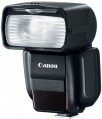Guide number
The guide number is the main characteristic that describes the power of the light pulse of the flash. It is described as the maximum distance (in metres) at which, at ISO 100 and f/1 lens speed (aperture 1), a flash is able to illuminate an "average" subject sufficiently for a normal exposure; in other words, at what distance from the flash it will be possible to normally shoot the scene at the specified ISO and aperture.
There are formulas by which, knowing the guide number, you can derive the practical shooting distance for each specific value of sensitivity and aperture. The simplest formula used to calculate the distance at ISO 100 is: S=N/f, where S is the distance, N is the guide number, f is the aperture value. For example, for a guide number of 56 and an f/2.8 lens, this distance would be 56/2.8 = 20 m. Increasing or decreasing sensitivity by a factor of 2 would increase or decrease the specified distance by approximately 1.4 times, respectively. If you need to calculate the distance as accurately as possible, you should refer to more detailed formulas that can be found in specialized sources.
Separately, it is worth noting that the leading numbers of flashes, usually, are indicated by manufacturers for specific focal lengths of lenses. This is due to the fact that the shorter the focal length and, accordingly, the wider the viewing angle, the more light is needed to illuminate the scene being shot and the more powerful the flash pulse should b...e (at the same distance). Therefore, when choosing by the guide number, it makes sense to pay attention to the focal length indicated by the manufacturer and select a model with a power reserve — especially since guide numbers are often prescribed for rather “long-range” lenses (with a focal length of about 80-100 mm in equiv. 35 mm).
Reload time
The time it takes the flash or generator (for studio flashes) to prepare for the next flash. The smaller it is, the better. This parameter is especially important for continuous shooting, when the interval between frames is small: if you often shoot in this mode, you should look for a flash with the shortest possible recycle time. Also note that the characteristics usually indicate the shortest recharge time; in some operating modes, it may be significantly more than stated.
Number of impulses
The number of flashes that the flash can fire without recharging the battery or changing batteries (see "Power"). This parameter is very approximate, because. in fact, it strongly depends on a number of factors: pulse duration, use of the display and its backlight (if any, see below), autofocus backlight (see "Features"), etc., and with replaceable batteries — even and on their quality. Often, manufacturers indicate in the characteristics the “perfect”, the maximum possible number of pulses — i.e. with their minimum duration, non-use of additional functions and even the optimal temperature regime for the battery. In reality, this figure may be lower. Nevertheless, the data indicated in the characteristics makes it quite possible to evaluate the battery life of the flash and even compare different models with each other.
Illumination angle
The angle of illumination provided by the on-camera light source (see "Type").
A large illumination angle, on the one hand, allows you to simultaneously cover a larger area, which is especially important when shooting long shots (at short focal lengths). On the other hand, to achieve sufficient brightness, this requires a large power of light sources, which accordingly affects the price and power consumption of the device. A small coverage angle, in turn, gives a small spot size of the light, but it allows you to achieve good brightness at a relatively low power.

